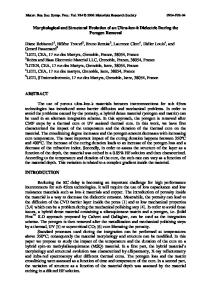The Kinetics of Damage Removal Metastable Carrier Concentration Relaxation and Secondary Defect Evolution During RTA
- PDF / 884,716 Bytes
- 6 Pages / 420.48 x 639 pts Page_size
- 70 Downloads / 273 Views
THE KINETICS OF DAMAGE REMOVAL METASTABLE CARRIER CONCENTRATION RELAXATION AND SECONDARY DEFECT EVOLUTION DURING RTA* XU Iq, TSIEN PEIHSIN AND LI ZHLJAN Tsinghna University, Institute of Microelectronics, Republic of China
Beijing,
The
People's
ABSTRACT The kinetics of damage removal, metastable carrier concentration relaxation and secondary defect evolution in As+-implanted and rapidly annealed silicon was studied m detail. It was found that these processes are characterized by different activation eergies. There is a critical temperature Tc for RTA. Ol when the annealing temperature is higher than T, with suitable time duration
can the RTA advantages be fully exloited. INTRODUCTION
Rapid thermal annealing (IrA) is becoming successful in VLSI technology because of its various advantages over conventional furnace annealing. It can be used to remove implantation-induced damages, to activate high dose of dopant while obtaining metastable carrier concentration and to reduce dopant prol broadening with less secondary defect. Metastable carrier concentration S.results in h eronductive layer. Reduced dopant diffusion makes it poible to range fabricat shallow junctin devices. Due to less secondary defect (projec defect), the electrical properties, including leakage current and breakdown voltage, are improved. Since all these three processes take place concurrently, in order to choose the optimal RTA condition, it is necessary to know the details of these processes. EXPERIMENTS AND RESULTS 6-8 alm P-type < i0o > silicon wafters and arsenic implantation at 12OKeV with a dose of I x 101 cm- 2 were used. The implanted samples were heated by infrared radiator of a RF induced graphite Il at 9006C 10006C 10800C and 1150C, with a set of times at each temperature, as listed in Table I. Channeling technique was used for analysing the annealed samples. Our previous paper 2,•,hs shown that a complete RTA process is composed of two steps (soli4 phase epitaxy and Table I. 9"(C I mi
damage 5 min damagej no 3 hrs
RTA conditions
1 0(C 7b sec damage Wsec jdamage
5 min 20 mm
no no
lOwbC
15 sec damage. 30sec no Wsec no
I1lPC
sec
8Wc
15 sec 30 se
no no no no
damage removal) and it is very difficult to remove the implatation-induced damage band near the original interface between amorphous layer caused by high dose implantation and bulk silicon. If the aligned spectrum for annealed *This work was supported by The National Natural Science Foundation of China Mat. Res. Soc. Symp. Proc. Vol. 100. 1988 Materials Research Society
684
samples are close to that of unimplanted, it is considered that the damage bands mentioned above have been removed and the whole RTA process has been completed. The damage removal times, which are defined as the shortest time duration needed for renioing the damage band, were 3 hours at 900"C, 5 minutes at 1000"C 30 seconds at 1080"C and 3 seconds at 1150*C respectively in this experimeni. Thus, an activation energy of about 5eV was derived for these process. The carrier concentration profiles sho
Data Loading...









